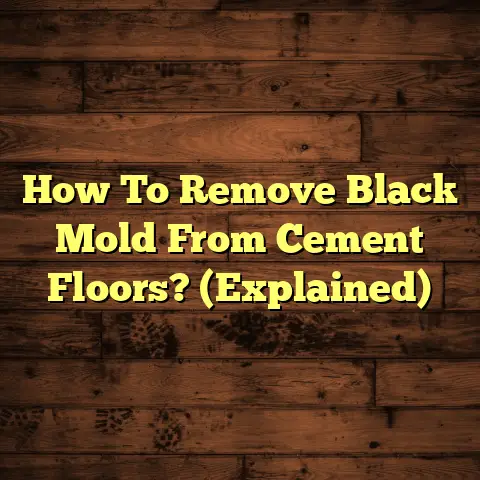How Much Does Spc Flooring Cost (Explained)
SPC (Stone Plastic Composite) flooring has emerged as a popular choice for homeowners and businesses alike due to its durability, aesthetic appeal, and cost-effectiveness.
This article will delve into the costs associated with SPC flooring installation, exploring various factors that influence pricing and providing you with a comprehensive guide to help you make informed decisions for your flooring project.
Overview of Cost Factors
When it comes to estimating the cost of SPC flooring, several key factors come into play:
1. Area Size
The total square footage of the space where the SPC flooring will be installed is perhaps the most significant factor in determining overall costs.
Larger areas will naturally incur higher material and labor costs.
2. SPC Flooring Type
SPC flooring comes in various styles and finishes, from simple designs to more intricate patterns.
The cost can vary significantly based on the quality and design of the tiles or planks selected.
3. Labor Costs
The cost of hiring professionals for installation can vary based on regional labor rates and the complexity of the job.
Skilled labor is essential for ensuring a proper installation.
4. Floor Removal
If existing flooring needs to be removed before installing SPC flooring, this will add to the overall cost.
The condition of the existing floor also plays a role in determining removal costs.
5. Subfloor Conditions
In some cases, the subfloor may require repairs or replacement, which can impact both material and labor costs.
Ensuring a solid foundation is crucial for the longevity of your new flooring.
6. Material Grade
The grade of SPC flooring affects not only aesthetics but also durability and price.
Higher-grade materials generally come with a higher price tag but offer better performance over time.
7. Room Size/Layout
The layout of the room can influence installation complexity.
Irregular shapes or unique features may require additional cuts and adjustments, which can increase labor costs.
8. Installation Type
SPC flooring can be installed using various methods, including click-lock or glue-down systems.
The chosen method may entail different costs associated with materials and labor.
Detailed Cost Breakdown
Price Ranges for SPC Flooring
- Material Costs: SPC flooring typically ranges from $2 to $7 per square foot, depending on quality and design.
- Labor Costs: Professional installation can add between $1.50 and $5 per square foot.
- Additional Costs: Include floor removal ($1 to $3 per square foot), subfloor repair/replacement ($1 to $5 per square foot), and any necessary underlayment ($0.50 to $2 per square foot).
Example Cost Scenarios:
- Small Room (100 sq ft):
- Material: $200 – $700
- Labor: $150 – $500
- Total: $350 – $1,200
- Medium Room (500 sq ft):
- Material: $1,000 – $3,500
- Labor: $750 – $2,500
- Total: $1,750 – $6,000
- Large Room (1,000 sq ft):
- Material: $2,000 – $7,000
- Labor: $1,500 – $5,000
- Total: $3,500 – $12,000
Comparison with Alternative Flooring Options
When considering SPC flooring, it’s helpful to compare it with other popular flooring options:
- Laminate Flooring: Ranges from $1 to $5 per square foot for materials and around $1 to $3 for installation.
Laminate is budget-friendly but lacks the durability of SPC. - Vinyl Flooring: Costs between $2 to $5 per square foot for materials and adds similar installation costs as SPC.
Vinyl is waterproof but may not have the same aesthetic appeal as SPC. - Carpet: Material costs typically range from $1 to $4 per square foot with installation costs from $1 to $3.
While soft and cozy, carpet is not as durable as SPC.
Signs Your Hardwood Floors Need Replacement
It’s essential to recognize when your hardwood floors may need replacement rather than refinishing:
- Severe Warping or Cupping: If your floors are significantly warped due to moisture damage, replacement may be necessary.
- Deep Scratches or Gouges: Extensive damage that cannot be repaired through refinishing may warrant replacement.
- Unpleasant Odours: Persistent musty smells can indicate underlying issues like mold or rot.
- Inconsistent Colouration: If your floors have faded unevenly or show signs of wear that cannot be repaired, consider replacement.
Pros and Cons of SPC Flooring
Pros:
- Durability: Highly resistant to scratches and dents.
- Water Resistance: Ideal for areas prone to moisture.
- Aesthetic Variety: Available in various designs that mimic natural hardwood.
- Easy Maintenance: Simple cleaning procedures compared to traditional hardwood.
Cons:
- Comfort: Harder underfoot compared to carpet or traditional hardwood.
- Resale Value: May not add as much value compared to real hardwood.
- Temperature Sensitivity: Can expand or contract with temperature changes.
Professional Installation vs DIY
Cost Differences
- Professional Installation: While it may cost an additional $1.50 to $5 per square foot, professional installation ensures proper alignment and sealing.
- DIY Installation: If you possess basic skills and tools, you could save on labor costs.
However, consider the following:- Tools Required: Cutting saws, measuring tapes, spacers, and possibly a flooring nailer.
- Skills Needed: Familiarity with subfloor conditions, cutting techniques, and installation methods.
Improper installation can lead to costly mistakes down the line, so weigh your options carefully before deciding on DIY versus hiring a professional.
Questions to Ask Hardwood Flooring Contractors
When seeking quotes or advice from contractors, consider asking:
- What types of SPC flooring do you recommend for my space?
- Can you provide references from previous clients?
- How long will the installation take?
- What warranties do you offer on materials and workmanship?
- Do you handle floor removal and subfloor repairs?
- What is included in your quote?
- How do you handle unexpected issues during installation?
Hardwood Floor Care and Maintenance Tips
To maximize the longevity of your SPC flooring:
- Regular Cleaning: Sweep or vacuum frequently to remove dirt and debris.
- Avoid Excess Moisture: Wipe up spills promptly; use a damp mop rather than soaking.
- Use Mats: Place mats at entryways to reduce dirt tracked onto floors.
- Furniture Pads: Use felt pads under furniture legs to prevent scratches.
- Avoid Harsh Chemicals: Use cleaners specifically designed for SPC flooring.
Conclusion
Understanding the costs associated with SPC flooring is crucial when planning your flooring project.
By considering all factors—from material types to installation methods—you can make informed decisions that align with your aesthetic preferences and budget constraints.
Whether opting for professional installation or taking on a DIY project, ensuring quality work will provide you with beautiful and durable floors that enhance your space for years to come.





